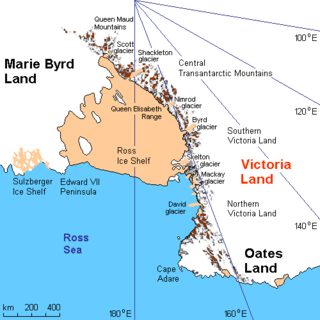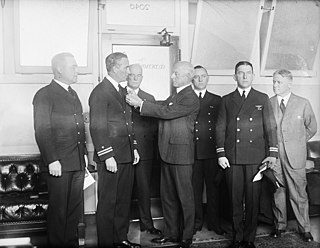Related Research Articles

Richard Evelyn Byrd Jr., an American naval officer, was a pioneering American aviator, polar explorer, and organizer of polar logistics. Aircraft flights in which he served as a navigator and expedition leader crossed the Atlantic Ocean, a segment of the Arctic Ocean, and a segment of the Antarctic Plateau. He is also known for discovering Mount Sidley, the largest dormant volcano in Antarctica.
Russell D. Owen was an American journalist employed by The New York Times. He covered Arctic and Antarctic exploration both as a reporter and in books. Owen Peak, originally named "Mount Russell Owen," was named in his honor after having traveled as a Times correspondent with the first Byrd Antarctic Expedition (1928-30).

Paul Allman Siple was an American Antarctic explorer and geographer who took part in six Antarctic expeditions, including the two Byrd expeditions of 1928–1930 and 1933–1935, representing the Boy Scouts of America as an Eagle Scout. In addition to being an Eagle Scout, Siple was also a Sea Scout. His first and third books covered these adventures. With Charles F. Passel he developed the wind chill factor, and Siple coined the term.
Ashley Chadbourne McKinley was an accomplished American aerial photographer and colonel in the U.S. Army Air Corps who helped pioneer aviation at subzero temperatures. He accompanied Richard E. Byrd as an aerial photographer on his expedition to the South Pole.
The Alexandra Mountains are a group of low, separated mountains in the north portion of Edward VII Peninsula, just southwest of Sulzberger Bay in Marie Byrd Land, Antarctica.

Little America was a series of Antarctic exploration bases from 1929 to 1958, located on the Ross Ice Shelf, south of the Bay of Whales.

Sir George Hubert Wilkins MC & Bar, commonly referred to as Captain Wilkins, was an Australian polar explorer, ornithologist, pilot, soldier, geographer and photographer. He was awarded the Military Cross after he assumed command of a group of American soldiers who had lost their officers during the Battle of the Hindenburg Line, and became the only official Australian photographer from any war to receive a combat medal. He narrowly failed in an attempt to be the first to cross under the North Pole in a submarine, but was able to prove that submarines were capable of operating beneath the polar ice cap, thereby paving the way for future successful missions. The US Navy later took his ashes to the North Pole aboard the submarine USS Skate on 17 March 1959.

Laurence McKinley Gould was an American geologist, educator, and polar explorer. He made expeditions to both the Arctic and Antarctic, and was chief scientist on Richard Evelyn Byrd's first Antarctic expedition, which Gould described in his 1931 book Cold: the Record of an Antarctic Sledge Journey. He served as president of Carleton College from 1945 to 1962, and president of the American Association for the Advancement of Science in 1964. His namesakes include the research vessel Laurence M. Gould as well as Antarctic features including Gould Bay, Gould Coast, and Mount Gould.

Scouting in the Antarctic is maintained by a single troop of Argentine Scouts and also by visiting Scouts from other nations who are participating in expeditions and research projects.

The Scott Glacier is a major glacier, 120 nautical miles long, that drains the East Antarctic Ice Sheet through the Queen Maud Mountains to the Ross Ice Shelf. The Scott Glacier is one of a series of major glaciers flowing across the Transantarctic Mountains, with the Amundsen Glacier to the west and the Leverett and Reedy glaciers to the east.

Isaac "Ike" Schlossbach was an American polar explorer, submariner and aviation pioneer.
The Hays Mountains are a large group of mountains and peaks of the Queen Maud Mountains of Antarctica, surmounting the divide between the lower portions of Amundsen Glacier and Scott Glacier and extending from the vicinity of Mount Thorne on the northwest to Mount Dietz on the southeast.

George John Dufek was an American naval officer, naval aviator, and polar expert. He served in World War II and the Korean War and in the 1940s and 1950s spent much of his career in the Antarctic, first with Admiral Byrd and later as supervisor of U.S. programs in the South Polar regions. Rear Admiral Dufek was the director of the Mariners' Museum in Newport News, Virginia after his retirement from the Navy in 1959.
The Rockefeller Mountains are a group of low-lying, scattered granite peaks and ridges, almost entirely snow-covered, standing 30 nautical miles south-southwest of the Alexandra Mountains on the Edward VII Peninsula of Antarctica.

George Otto Noville, also known as "Noville" and "Rex," was a pioneer in polar and trans-Atlantic aviation in the 1920s, and winner of the Distinguished Flying Cross. He served with Commander Richard E. Byrd on the historic 1926 flight to the North Pole, as third in command. He was flight engineer on the America, and was executive officer of Byrd's Second Antarctic Exploration 1933-35. Mount Noville and Noville Peninsula in Antarctica are named after him.

Harold Irving June (1895–1962) was a machinist, an aviator, a test pilot, and an explorer in Antarctica. He is best known for his 1928–1930 service in the first Antarctic expedition of Admiral Richard E. Byrd. Sitting in the co-pilot's seat with supplemental radio duties, he flew with Byrd, pilot Bernt Balchen, and photographer Ashley McKinley over the South Pole on November 29, 1929.
The Byrd Antarctic Expedition Medal is a Congressional medal established by an Act of Congress in 1930 to commemorate the Byrd Antarctic Expedition of 1928–1930. Presented in gold, silver and bronze, the medals were awarded to 81 individuals associated with the expedition, for a total cost of $6,560.

Dean Cullen Smith was a pioneer American mail pilot, test pilot, flying instructor, Antarctic pilot, and airline pilot. At 17 years of age, he became the youngest flight instructor in U.S. Army history. He was a lead pilot for the U.S. Postal Service's airmail service, and was the first pilot to initiate night air mail flights. He was an executive for many airlines and aircraft companies.

The City of New York was a steam barquentine known for being Richard E. Byrd's flagship on his 1928–30 exploration of Antarctica, mistakenly for the rescue of Ernest Shackleton in 1915, and most infamously for claims of being the ship that failed to come to the aid of the Titanic in 1912. Her name was changed several times; originally named Samson (1885–1914), she was renamed the Jacobsen (1915–1919), and then the Belsund (1919–1926), and back to Samson (1926–1928), before being finally dubbed the City of New York in 1928.
Franklin Alton Wade (1903–1978) was an American geologist. One of his chief scientific interests was the geology of Antarctica, to which he traveled several times, including twice with the explorer Admiral Richard E. Byrd.
References
- ↑ "Byrd Antarctic Expedition (1st: 1928–1930): Photo Album 1". Ohio State University Libraries . Ohio State University. 1928–1930. hdl:1811/25325 . Retrieved January 31, 2021.
- ↑ "Tennant Peak". Australian Antarctic Data Centre. Government of Australia. 2021. Retrieved January 31, 2021.